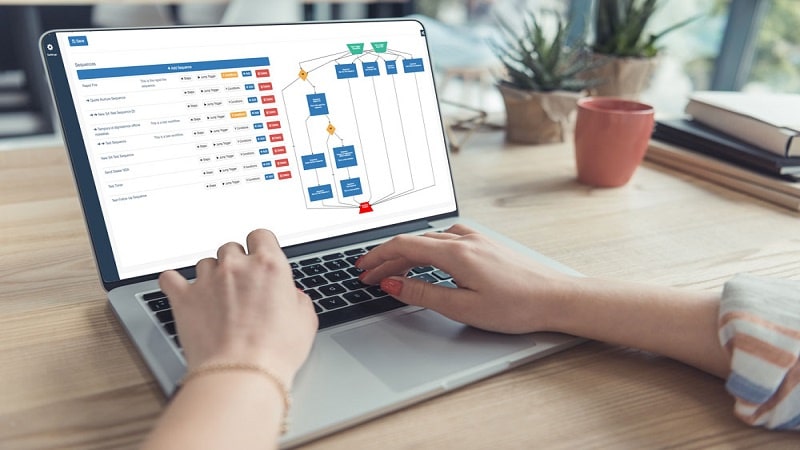
Discover the benefits and functionalities of form automation software in this guide. Learn how it can streamline your business processes, boost productivity, and reduce errors.
Manual form filling and data entry are time-consuming and prone to errors. Therefore, there's a growing demand for automation tools that can help streamline these processes. Form automation software offers a streamlined solution by automating the entire form creation, submission, and data management process.
Whether collecting customer feedback, managing employee onboarding, or processing sales orders, form automation software provides a robust toolkit to simplify and enhance these workflows. This guide will delve into everything you need about form automation software below.
Features Of Form Automation Software

Form automation software offers many features that streamline the entire form creation and data management process. Here are some of the key features that make form automation software indispensable for businesses.
- Forms Automation: Form automation software eliminates the need for manual form filling and data entry. With forms automation, you can streamline the data collection process from creation to data submission and storage, saving time and reducing errors.
- Drag-and-drop Form Builder: With a user-friendly drag-and-drop form builder, even non-technical users can easily create customized forms. This feature allows you to add fields, rearrange them, and design the form layout with simplicity and convenience.
- Pre-built Form Templates: Form automation software often has a library of pre-built form templates. These templates cover many use cases, such as surveys, feedback, and registration forms. Using pre-built templates can significantly speed up the form-creation process.
- Conditional Logic: Conditional logic is a powerful feature that enables dynamic form behavior based on user input. You can set rules and conditions that determine which fields are shown or hidden, which questions are required, or even trigger specific actions based on user responses. This ensures a personalized and seamless form-filling experience.
- Data Validation And Error Checking: Form automation software includes robust data validation and error-checking capabilities. It ensures that the information entered into the form meets specified criteria, such as correct email formats, valid dates, or required fields. Real-time validation and error messages help users correct mistakes and ensure data accuracy.
- Analytics And Reporting Capabilities: Form automation software provides robust analytics and reporting features. It allows you to gather insights into form submission data, track response rates, analyze user behavior, and generate comprehensive reports. These analytics help you make data-driven decisions, identify trends, and improve your forms for better performance.
By leveraging these capabilities, organizations can enhance efficiency, improve data accuracy, streamline processes, and gain valuable insights for informed decision-making.
Benefits Of Form Automation Software

Form automation software offers many benefits that can significantly transform how organizations handle their form-related processes. Here are some of its key advantages.
1. Increased Efficiency And Productivity
Form automation software eliminates the need for manual data entry, repetitive tasks, and paper-based processes. Automating form creation, submission, and data management streamlines workflows and reduces the time and effort required to handle forms.
This increased efficiency allows employees to focus on more strategic tasks, enhancing productivity across the organization.
2. Time And Cost Savings
Automating form processes translates into significant time and cost savings. Employees spend considerable time on form creation, printing, distribution, data entry, and verification with manual processes.
Form automation software streamlines these tasks, allowing for faster form creation, digital distribution, and automated data capture. As a result, organizations save valuable time and resources that can be allocated to other critical activities.
3. Reduction Of Errors And Data Inconsistencies
Manual form filling and data entry are prone to errors, such as typos, missing information, or incorrect data formatting. Form automation software helps reduce errors by incorporating data validation rules, mandatory fields, and error-checking mechanisms.
It ensures that collected data is accurate, complete, and consistent, reducing the need for manual corrections and minimizing the potential for data-related issues.
4. Improved Data Security And Compliance
Form automation software offers robust data security measures to protect sensitive information. Unlike paper forms that unauthorized individuals can quickly lose, damage, or access, digital forms provide enhanced security through encryption, access controls, and audit trails.
Additionally, form automation software facilitates compliance with data protection regulations, such as GDPR or HIPAA, by ensuring data integrity, confidentiality, and consent management.
5. Enhanced Customer Experience
Forms often serve as a crucial touchpoint between organizations and their customers. With form automation software, organizations can create intuitive, user-friendly forms that enhance the overall customer experience.
Features like conditional logic, pre-filled fields, and progress indicators make the form-filling process more accessible and engaging for users. Automated email confirmations, personalized responses, and timely follow-ups contribute to a seamless and satisfying customer journey.
Conclusion
Form automation software has become an invaluable tool for organizations across various industries. Its key features empower users to streamline data collection, improve accuracy, automate processes, and gain valuable insights.
Organizations can unlock new levels of efficiency, productivity, and data-driven decision-making by understanding the potential and benefits of form automation software.










